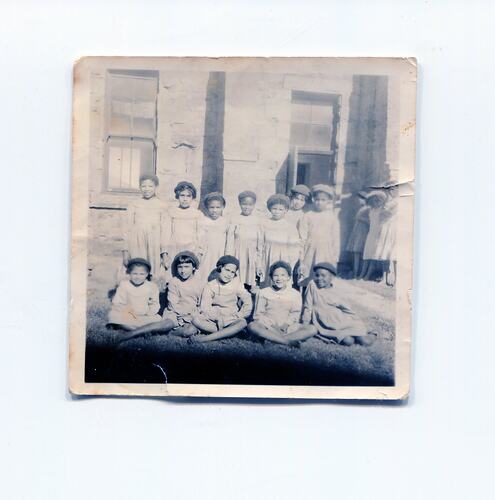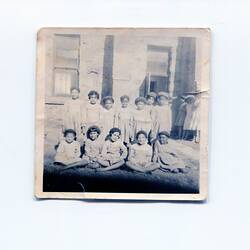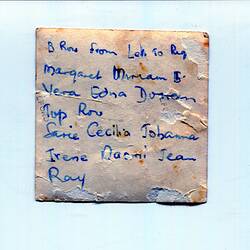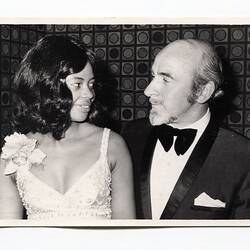Summary
Black and white photograph of a group of young girls from Leliebloem House, an orphanage in Cape Town, 1950s. Their names are listed on the back of the photograph. Sylvia Boyes (who is not present in this photograph) grew up in Leliebloem House until the age of 18, often helping with the younger residents.
Sylvia Boyes (a South African-born orphan) and Lindsay Motherwell (a Melbourne-born drummer) met in Cape Town, South Africa in 1967 through their theatre connections. They fell in love but due to apartheid laws were forced to leave South Africa to marry in London. They subsequently relocated permanently to Melbourne in 1970.
Description of Content
Group of 12 girls, seven standing and five sitting cross-legged in front of them. They all wear white dresses and dark-coloured caps. Behind them is a brick building, and a few other children are visible on the right of the image.
Physical Description
Black and white photograph
Significance
Statement of Historical Significance:
This collection provides a significant opportunity to represent political and personal freedom as a motivation for migrating to Australia within the international context of both apartheid in South Africa and the end of the White Australia policy in Australia. The personal narrative is well documented and the objects provide a material way to follow the lives of both Lindsay and Sylvia, both separately and where they coincide in South Africa and onwards together to Melbourne. While this is ultimately a love story, it plays out through the collection against the backdrop of apartheid South Africa, sixties London and an increasingly multicultural Australia.
More Information
-
Collecting Areas
-
Original Owner
-
Format
Photograph, Black & White
-
Inscriptions
'B Row from Left to Rig/Margaret Miriam &/Vera Edna Dorreen/Top Row/Sarie Cecilia Johanna/Irene Naomi Jean/Ray'
-
Classification
-
Category
-
Discipline
-
Type of item
-
Object Dimensions
59 mm (Width), 59 mm (Height)
-
Keywords
South African Immigration, Travel, Musicians, Jazz Bands, Immigration Policies, Apartheid, Racism, Orphanages, Children



